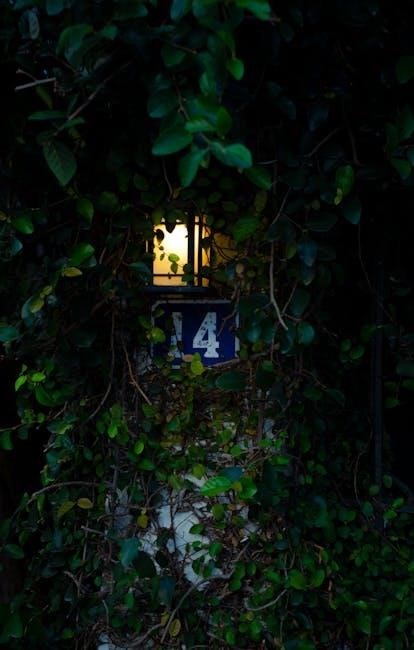14 nichoirs et abris à fabriquer pdf

Birdhouses and shelters provide essential habitats for birds and beneficial insects‚ supporting biodiversity and ecosystem health. Building these structures is a rewarding conservation effort and creative activity.
Importance of Birdhouses and Shelters
Birdhouses and shelters play a vital role in supporting biodiversity by providing safe habitats for birds and beneficial insects. They substitute for natural nesting sites‚ often destroyed due to environmental changes‚ ensuring species survival. By installing these structures‚ you attract birds that help control garden pests and pollinators‚ fostering ecosystem balance. Shelters also protect insects like bees and ladybugs‚ which are crucial for agriculture and biodiversity. This simple conservation effort not only aids wildlife but also enhances garden health and sustainability‚ making it a meaningful contribution to environmental preservation.
Overview of the 14 Birdhouses and Shelters

This collection of 14 birdhouses and shelters offers a diverse range of designs to attract various bird species‚ beneficial insects‚ and wildlife. From simple wooden birdhouses to intricate insect hotels‚ each structure is tailored to meet specific needs. The martin house‚ for example‚ is designed for colonial nesting‚ while the insect hotel supports pollinators like bees. Other designs include double entrance birdhouses for predator protection and ground-level shelters for small mammals. These plans cater to different skill levels‚ using materials like wood‚ bamboo‚ and recycled items. Each shelter is crafted to provide safe habitats‚ encouraging biodiversity and offering a creative way to support local wildlife.

Materials and Tools Needed
Essential materials include wood‚ nails‚ screws‚ waterproof roofing‚ and recycled items. Tools required are saws‚ drills‚ sandpaper‚ and waterproof glue for durable construction.
Essential Materials for Birdhouse Construction
Building birdhouses requires durable‚ weather-resistant materials. Wood‚ such as pine or cedar‚ is ideal for construction due to its natural resistance to rot. Nails or screws are used for assembly‚ while waterproof glue ensures longevity. A sloped roof made of wood or metal prevents water seepage. Pre-drilled holes and hinges facilitate easy cleaning and maintenance. Recycled materials‚ like reclaimed wood or plastic‚ can be used for eco-friendly options. Additionally‚ sawdust or wood shavings may line the floor for insulation. Ensure all materials are non-toxic and safe for wildlife. Properly treated wood or naturally rot-resistant varieties like cedar are recommended for outdoor durability.
Tools Required for Building Birdhouses
Constructing birdhouses requires essential tools for precise and safe assembly. A saw or power saw is necessary for cutting wood planks to the required dimensions. Sandpaper ensures smooth edges‚ preventing splinters. A drill or screwdriver is used for making entrance holes and securing parts together. Nails or weatherproof screws are ideal for durable connections. A hammer helps in tapping pieces into place. Measuring tape and square ensure accuracy in cuts and angles. Waterproof glue reinforces joints‚ while a paintbrush can apply protective finishes. Safety gloves and goggles are recommended to protect against injuries. Optional tools include a jigsaw for curved cuts and clamps for holding pieces steady during assembly. Proper tools ensure a sturdy and long-lasting birdhouse.

Step-by-Step Instructions for Each Birdhouse

Each birdhouse design includes detailed guides‚ from simple to complex builds‚ ensuring safety‚ durability‚ and appeal to various bird species and beneficial insects.
Birdhouse #1: Simple Wooden Birdhouse
This birdhouse is designed for beginners‚ offering a straightforward construction process. It features a basic wooden structure with a sloped roof and a single entrance hole. The dimensions are carefully planned to accommodate small bird species. Materials include untreated wood‚ a saw‚ drill‚ hammer‚ and nails. Instructions begin with cutting the wood into the required pieces‚ followed by assembling the base‚ walls‚ and roof. Mounting hardware is added for easy installation. The design ensures durability and protection from the elements. This birdhouse is ideal for attracting birds like wrens or sparrows and can be easily customized with paint or additional features. It’s a great starting point for those new to birdhouse building.
Birdhouse #2: Double Entrance Birdhouse
The Double Entrance Birdhouse is designed to provide a safe nesting space while offering an innovative solution for bird protection. This model‚ created by Dr. Otto Henze‚ features two large entry points to accommodate birds that typically nest in semi-open environments‚ such as robins or swallows. The double entrance helps deter predators‚ giving birds an advantage. Constructed from untreated wood‚ this birdhouse includes a sloped roof for weather protection and a compact design for versatility. It is ideal for attracting a variety of species and can be mounted in gardens or woodlands. The design promotes easy cleaning and maintenance‚ making it a practical choice for bird enthusiasts. This birdhouse is a great option for those looking to support local bird populations while adding a unique feature to their outdoor space.
Birdhouse #3: Insect Hotel
The Insect Hotel is a unique structure designed to attract and shelter beneficial insects‚ such as solitary bees and ladybugs‚ which play a vital role in pollination and pest control. Constructed from natural materials like bamboo‚ wood‚ and straws‚ this hotel features multiple chambers to accommodate various insect species. Its design encourages biodiversity by providing a safe habitat for insects to nest and lay eggs. The Insect Hotel is easy to build and can be customized to fit different garden settings. By installing it in a sunny spot‚ you support local wildlife and contribute to a healthier ecosystem. Regular maintenance‚ like cleaning and replacing materials‚ ensures its effectiveness year-round.
Birdhouse #4: Shelter for Beneficial Insects
The Shelter for Beneficial Insects is a specialized structure tailored to protect and attract insects like ladybugs‚ lacewings‚ and parasitic wasps. These insects are essential for natural pest control‚ reducing the need for pesticides. Built using natural materials such as wood‚ bamboo‚ and straws‚ the shelter mimics the insects’ natural habitats‚ offering a safe space for nesting and reproduction. Its simple design features multiple small cavities and narrow openings to ensure protection from predators. Placing it in a sunny‚ sheltered spot enhances its effectiveness. Regular maintenance‚ like cleaning and replenishing materials‚ supports the health of these beneficial insects. This shelter is a practical way to promote biodiversity and ecological balance in your garden.
Birdhouse #5: martin House
Birdhouse #5: Martin House
The Martin House is a specialized shelter designed to attract Purple Martins‚ known for their insect-hunting abilities. These structures typically feature multiple chambers to accommodate the social nature of martins‚ which often nest in colonies. Built from durable materials like cedar or pine‚ the house includes entrance holes‚ nesting compartments‚ and ventilation to ensure a healthy environment. A roof overhang protects against rain‚ while a clean-out door allows for easy maintenance. Mounting the house on a pole and facing it eastward maximizes sun exposure‚ which martins prefer. Regular cleaning and proper placement are essential to attract and support these beneficial birds‚ enhancing biodiversity and pest control in your garden naturally.
Birdhouse #6: Nesting Box for Raptors
The Nesting Box for Raptors is designed to provide a safe haven for birds of prey‚ such as owls or hawks. Built with sturdy‚ untreated wood‚ this box features a large‚ spacious interior to accommodate the nesting needs of larger bird species. The design includes a roof overhang to protect against rain and a wide entrance hole for easy access. Drainage holes in the floor ensure moisture control‚ while the box’s height and placement on a tall pole deter predators. Mounting it in an open area‚ facing east to capture morning sun‚ creates an ideal environment. Regular cleaning and proper maintenance are essential to support these magnificent birds and promote biodiversity in your ecosystem.
Birdhouse #7: Open-Front Birdhouse
The Open-Front Birdhouse is a versatile and simple design‚ ideal for birds that prefer easy access to their nesting area. Constructed with durable‚ untreated wood‚ this birdhouse features a completely open front‚ allowing birds to enter freely. The design includes a sloped roof to prevent water entry and a flat floor for nesting material. Its compact size makes it suitable for small bird species like wrens or sparrows. Mounting it in a shaded area‚ such as under a tree canopy‚ provides protection from harsh weather. The open design also allows for easy cleaning and maintenance‚ ensuring a safe and healthy environment for nesting birds. This birdhouse is a great choice for beginners due to its straightforward construction and adaptability to various bird species.
Birdhouse #8: Bird Feeder with Shelter
The Bird Feeder with Shelter combines functionality and protection‚ offering a unique solution for bird enthusiasts. This design integrates a feeding area with a small shelter‚ providing birds with both food and a safe retreat from predators or harsh weather. Constructed from durable materials like wood or recycled plastic‚ it features a roof to protect the feed and a compartment for nesting. The open design allows easy access for birds while keeping the interior dry. This birdhouse is ideal for attracting species like robins‚ sparrows‚ and finches. Its dual-purpose nature makes it a practical and attractive addition to any backyard‚ promoting birdwatching while supporting local wildlife. Regular cleaning and refilling of the feeder ensure a welcoming environment for birds year-round.
Birdhouse #9: Wooden Nesting Box
The Wooden Nesting Box is a simple yet effective shelter designed to provide a safe haven for birds to nest and raise their young. Crafted from untreated wood‚ this box features a sleek design with a small entrance hole and a removable roof for easy cleaning. The box is ideal for species like bluebirds‚ swallows‚ and wrens‚ offering protection from predators and harsh weather. Its compact size makes it easy to install in various locations‚ such as tree trunks or fence posts. The natural wood finish blends seamlessly into outdoor environments‚ promoting a harmonious coexistence between wildlife and your backyard. Regular maintenance ensures the box remains a welcoming habitat for birds year after year.
Birdhouse #10: Bamboo Birdhouse
The Bamboo Birdhouse is a sustainable and eco-friendly option for bird enthusiasts. Made from natural bamboo‚ it offers a durable and weather-resistant shelter for small bird species. The design features a small entrance hole‚ a compartment for nesting‚ and a sloped roof to ensure water runoff. Bamboo’s natural appeal attracts birds while blending into garden or woodland settings. This birdhouse is ideal for wrens‚ sparrows‚ or other small birds. It requires minimal maintenance and can be easily mounted on trees or poles. The use of bamboo promotes environmental sustainability‚ making it a great choice for eco-conscious birders. Regular cleaning ensures it remains a safe and welcoming habitat for birds.
Birdhouse #11: Recycled Material Birdhouse
The Recycled Material Birdhouse is an eco-friendly and creative project that transforms discarded items into a functional shelter for birds. Using materials like plastic bottles‚ cardboard tubes‚ or reclaimed wood‚ this birdhouse promotes sustainability and reduces waste. It is an excellent DIY project for those looking to contribute to environmental conservation while supporting local bird populations. The design can be tailored to attract specific bird species‚ with proper ventilation and drainage to ensure comfort and safety. This birdhouse is not only budget-friendly but also a great way to educate others about reusing materials. Its unique appearance adds charm to any garden or backyard‚ making it a rewarding and meaningful endeavor for nature lovers. Regular maintenance‚ like cleaning and securing the structure‚ ensures it remains a welcoming habitat for birds. This eco-conscious approach fosters a deeper connection with the environment while providing a practical solution for bird conservation.
Birdhouse #12: Hanging Birdhouse
The Hanging Birdhouse is a versatile and charming option for attracting birds to your yard. Designed to be suspended from a tree or pole‚ it provides an elevated refuge for small bird species. Its compact design ensures easy installation and maintenance‚ while the open or enclosed structure can cater to various bird preferences. The hanging feature allows for optimal placement away from predators and harsh weather conditions. Crafted from durable materials like wood or recycled plastic‚ this birdhouse is both eco-friendly and long-lasting. Proper ventilation and drainage holes ensure a comfortable habitat for nesting birds. This model is ideal for backyard birdwatchers who want to support local wildlife while adding a decorative element to their outdoor space. Regular cleaning is essential to maintain a safe environment for its feathered residents.
Birdhouse #13: Ground-Level Shelter
The Ground-Level Shelter is an innovative design tailored for birds and small wildlife that prefer nesting or resting near the ground. This shelter is ideal for species like ground-dwelling birds‚ small mammals‚ or beneficial insects. Constructed from natural materials such as wood or recycled plastic‚ it blends seamlessly into outdoor environments. Its low-profile design provides protection from harsh weather and predators‚ while the open-front structure allows easy access. Perfect for beginners‚ this shelter is simple to assemble and install‚ requiring minimal tools and materials. Placing it in a shaded‚ dry area ensures optimal conditions for its inhabitants. Regular maintenance‚ such as cleaning and securing the structure‚ ensures its longevity and effectiveness in supporting local wildlife.
Birdhouse #14: Multi-Chamber Birdhouse
The Multi-Chamber Birdhouse is a versatile and spacious design‚ offering multiple compartments to accommodate various bird species or even small mammals. Its sturdy construction‚ often using durable materials like untreated wood or recycled plastic‚ ensures longevity and protection from the elements. This birdhouse is particularly beneficial for attracting multiple families or species‚ as each chamber provides a private nesting space. Easy to assemble‚ it features separate entrances for each compartment‚ reducing competition and predation risks. Ideal for gardens or woodlands‚ it promotes biodiversity by supporting a diverse range of wildlife. Regular cleaning and maintenance are essential to ensure the health and safety of its inhabitants.

Installation and Placement Tips
Proper installation and placement are crucial for birdhouse success. Position them in sunny spots‚ at appropriate heights‚ and ensure protection from predators and harsh weather conditions.
Choosing the Right Location for Birdhouses
Selecting the ideal location for your birdhouse is vital for attracting birds and ensuring their safety. Birds prefer open areas with nearby trees for nesting and protection. Place birdhouses in sunny spots‚ as many species prefer warmth‚ and ensure they are positioned at least 3 to 5 feet off the ground to deter predators. Avoid areas with high foot traffic or dense vegetation‚ as these can discourage birds from nesting. Consider the specific needs of the bird species you want to attract‚ such as open fields for swallows or woodland edges for robins. Proper placement enhances biodiversity and supports local wildlife effectively.
Installing Birdhouses at Optimal Heights
Installing birdhouses at the right height is crucial for ensuring bird safety and attracting the desired species. The optimal height varies depending on the bird type‚ ranging from 3 to 10 feet off the ground. For example‚ bluebirds and swallows prefer lower heights‚ while larger birds like owls may require taller installations. Ensure the birdhouse is placed out of predators’ reach but still accessible for maintenance. Face the entrance east to southeast to provide morning sunlight‚ which helps regulate temperature. Avoid placing birdhouses near branches that could allow predators to jump in. Install during the nesting season to encourage occupancy and support local wildlife effectively.

Maintenance and Care
Regular cleaning ensures a safe environment. Inspect for damage and pests. Seasonal checks maintain functionality. Protect from predators to safeguard birds and beneficial insects effectively.
Cleaning and Upkeeping Birdhouses
Regular cleaning is crucial for maintaining birdhouses and ensuring the health of their inhabitants. Remove old nesting material and debris annually‚ preferably after the breeding season. Use gloves and a mild detergent to scrub surfaces‚ then rinse thoroughly. Allow the birdhouse to dry completely before reinstalling it. Inspect for signs of damage‚ pests‚ or mold‚ addressing issues promptly to prevent harm. Clean out nesting boxes before each nesting season to discourage parasites and diseases. Proper upkeep ensures the longevity of the birdhouse and creates a safe environment for birds and beneficial insects to thrive year after year.
Seasonal Maintenance Tips
Seasonal maintenance ensures birdhouses remain safe and functional year-round. In spring‚ clean and inspect birdhouses for damage or mold‚ ensuring they are ready for nesting. During summer‚ monitor for pests and ensure ventilation to prevent overheating. In autumn‚ repair any damage and install rooves or predator guards. Winterize birdhouses by adding insulation or protective covers to shield against harsh weather. Regularly check for wear and tear‚ and reapply protective finishes as needed. Seasonal adjustments help maintain the health of bird populations and extend the lifespan of the birdhouses. Tailor care to the specific needs of each bird species and shelter type for optimal results.

Tips for Beginners
Building birdhouses can be a fun and rewarding project. Start with simple designs‚ use durable materials‚ and ensure proper ventilation. Place birdhouses in sunny spots‚ maintain them regularly‚ and be patient as birds discover their new homes.

Common Mistakes to Avoid
When building birdhouses and shelters‚ avoid using untreated wood‚ as it can rot quickly. Ensure proper ventilation to prevent overheating and moisture buildup. Avoid placing birdhouses in shaded or low-lying areas‚ as they attract predators. Do not use nails that are too long‚ as they can harm the birds. Avoid overcrowding the birdhouse with too many chambers‚ which can lead to competition among birds. Do not forget to add drainage holes to prevent waterlogging. Avoid using bright colors or shiny materials that might deter birds. Ensure the entrance hole is the correct size for the target species. Regularly clean and maintain the birdhouses to ensure their longevity and effectiveness.
Encouraging Bird Nesting
To attract birds to nest‚ ensure birdhouses are placed in locations with ample food sources and shelter. Install birdhouses facing east or southeast to protect from harsh winds and direct sunlight. Use untreated wood to avoid chemical harm and ensure proper ventilation for airflow. Mount birdhouses at appropriate heights based on the species to enhance safety. Avoid disturbances near nesting sites to create a peaceful environment. Regularly clean and maintain birdhouses to encourage repeated use. Consider adding predator guards to protect nests. Plant native vegetation nearby to provide additional habitat and food sources‚ fostering a welcoming environment for nesting birds.
Building birdhouses and shelters is a rewarding way to support biodiversity and conservation efforts‚ offering birds and insects safe habitats while enhancing your outdoor space naturally.
Final Thoughts on Building Birdhouses
Creating birdhouses and shelters is a simple yet impactful way to support local wildlife. By providing safe habitats‚ you contribute to biodiversity and ecosystem balance. Each design‚ from nesting boxes to insect hotels‚ offers unique benefits. These projects are perfect for beginners and experienced crafters alike‚ fostering creativity and a connection to nature. Regular maintenance ensures the longevity of these structures‚ benefiting birds and insects for years. Whether you build one or all 14 designs‚ every effort helps protect species and enhance your outdoor space. Start your project today and enjoy the rewarding experience of giving back to nature while learning new skills.

Encouragement to Start Your Project
Building birdhouses and shelters is a rewarding and impactful hobby that benefits both wildlife and the environment. With 14 diverse designs to choose from‚ you can create habitats tailored to specific species‚ from birds to beneficial insects. Whether you’re a novice or an experienced crafter‚ these projects are achievable and offer a sense of accomplishment. Starting your project is the first step toward contributing to biodiversity and enjoying the joy of watching wildlife thrive in your yard. Gather your materials‚ choose a design‚ and begin crafting—every birdhouse you build makes a difference. Let your creativity shine and take pride in supporting nature!